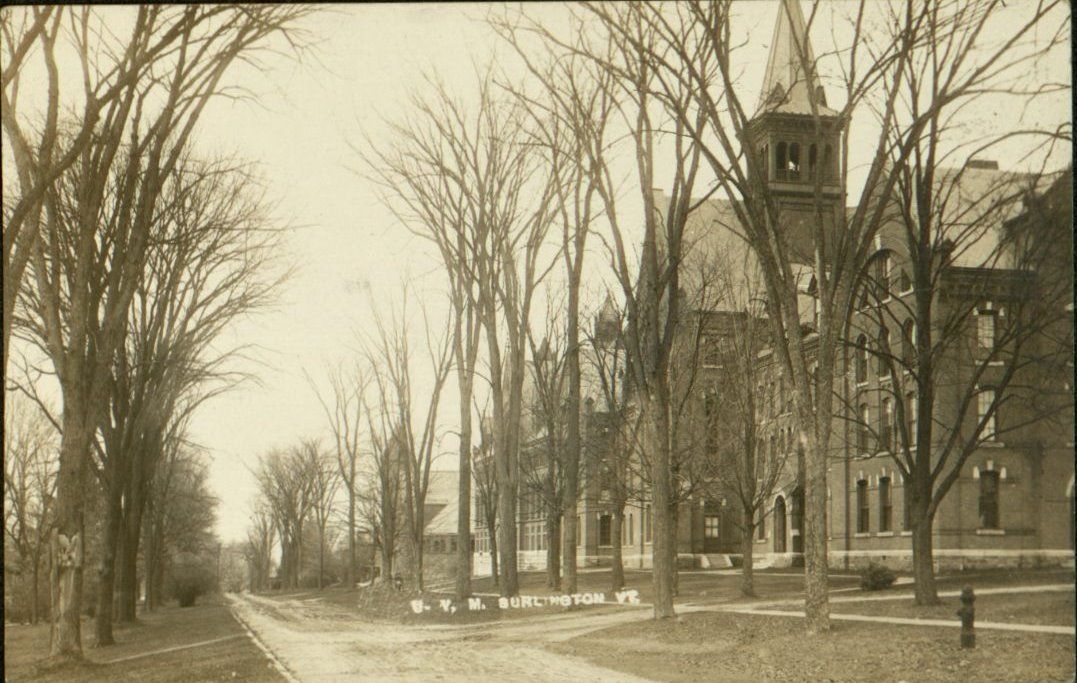American Elm : Dutch Elm Disease

American elms that are dying from Dutch elm disease line the street in front of Old Mill building and Billings Library at the University of Vermont. (Postcard Collections, Special Collections, Bailey-Howe Library, University of Vermont)
’It is all changed.
The great trees are falling
Farmer-felled,
Elm-diseased,
Old-age-dying,
And the hedges,
The scale-subduing hedges,
Are torn out now, obliterated.
No-one will frame a landscape for home again’”
(Clouston & Stansfield, 1979, p. 15).
-Thomas Sharpe
Since Americans loved American elm trees and thought of them as a symbol of the country, many people were devastated when the Dutch elm disease killed most of the American elms in the United States. Estimates of around 77 million to 100 million American elms died from Dutch elm disease nationwide.
Dutch elm disease comes from an invasive pest from China. These invasive beetles came over on imported wood in 1930. The first reporting of Dutch elm disease was in Ohio. A Dutch researcher was the first one to identify the disease, hence the disease’s name. As more trees started to die from Dutch elm disease since 1930, the federal, state, and local governments spent a lot of money toward trying to save the trees and stop the disease from spreading even more. Unfortunately, the governments were unable to do anything because so many trees had been planted so close to each other, lining streets, that the disease could spread quickly. As a result, in the 1960s the American elms practically disappeared.
How Dutch elm disease kills the American elm: The small brown beetles that came to the United States from China burrow into the bark of the American elm. The beetles carry spores of the fungus, Ophiostoma ulmi. This fungus clogs the tree’s systems, so the tree cannot get and circulate fluids or nutrients. One way to think about this is the fungus clogs the tree’s arteries and the elm has a very slow heart attack. Some symptoms of Dutch elm disease as the disease spreads throughout the tree, are the leaves start yellowing (when they are not supposed to), twigs die and fall off, and eventually branches will die and fall off until only the trunk remains. As the disease gets worse, the bacteria from the fungus that is inside the tree break down the cells of the wood. Long-horned beetles are attracted to the smell of dying wood, so they lay their eggs on the dying American elm and the chew the wood. The larvae of the long-horned beetles burrow into tree carrying the bacteria and fungal spores deeper into the tree. Pileated woodpeckers (the kind of woodpeckers that make very big holes) love to eat long-horned beetle grubs, so they make their huge wholes in the trunk of the dying American elm. These holes kill the tree more because then water can get inside the trunk of the elm and more fungus can grow in the trunk of the tree.
Result from the Dutch elm disease: In the 1990s in Beltsville, Maryland some researchers at the Department of Agriculture’s National Arboretum station found that some elms were resistant to Dutch elm disease. So, in 1996, Roger Holloway of Georgia, started creating disease-resistant American elms. After a lot of effort to create this type of tree, Holloway was able to sell 12,000 of these disease-resistant American elms at Home Depot in 2006. Holloway’s dream is to bring American elms back to every street in the United States. So, in 2008 he planned to grow 34,000 American elms for Home Depot and in 2009 he planned to grow 70,000. Holloway is one of the main sellers of these new disease-resistant American elms, but there are other smaller farms that grow disease-resistant American elms. In order to try to bring these trees back into the American landscape, Holloway (2007) makes sure that every tree has a tag on it that says, “’Plant this tree and help restore a lost piece of American history.’” There is also another tag on the trees explaining that this type of American elm is disease-resistant.
After the Dutch elm disease, people tried creating more diversity among plants and trees, especially where there had been American elms. This way one disease does not wipe out all of the plants or trees in one area, like what happened with Dutch elm disease and the American elms. One example of people trying to create more diversity among plants and tress was at UVM in 1972, when a new grounds manager was hired, Dick Streeter. Streeter wanted the trees on UVM’s campus to be more diversified, after Dutch elm disease killed almost all of the American elms on campus. So, he planted native and exotic trees. Disease-resistant types of elms, such as the Valley Forge, New Harmony, and Jefferson, are also being encouraged to be planted, so there is not another epidemic of elms.
